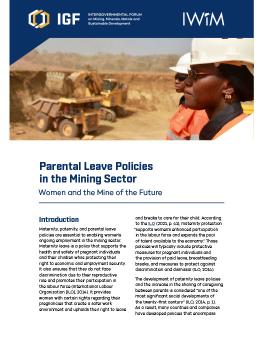
Parental Leave Policies in the Mining Sector
An in-depth look at international and national parental leave frameworks and policies across 12 countries.
Maternity, paternity, and parental leave policies are essential to enabling women’s ongoing employment in the mining sector. These policies support the health and safety of pregnant individuals and their children while protecting their right to economic and employment security. They also ensure that workers do not face discrimination due to their reproductive role.
This paper takes an in-depth look at parental policies in the mining sector. The purpose of this paper is to review the existing international and national frameworks as well as the publicly available parental leave policies of the 12 countries that were examined as part of the IGF-led Women and the Mine of the Future project: Argentina, Australia, Brazil, Canada, Chile, Colombia, Ghana, Mongolia, Peru, South Africa, Sweden, and Zambia.
The paper first details the international and national frameworks around parental policies for each country, followed by an analysis of mining company policies that operate in these countries. Finally, the paper analyzes interesting trends regarding parental policies in the mining sector and outlines some considerations for the mine of the future.
You might also be interested in
IGF Case Study: Leveraging Technologies for Gender Equality in Mining Communities
How can sharing technological infrastructure support gender equality and serve the broad betterment of mining communities?
Women and the Mine of the Future
Uncovering the gender-disaggregated employment profile for large-scale mining, focusing on women and their occupations in 12 countries.
IGF Mining Policy Framework
A compendium of best practices for governments to manage the full range of issues in the mining sector.
Integrating Gender Equality and Mine Closure: Actions for governments
Report on how mine closure and gender equality intersect and how governments can ensure closure practices and policies integrate gender considerations.